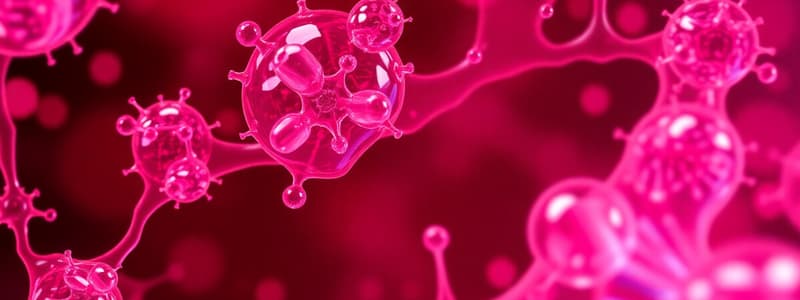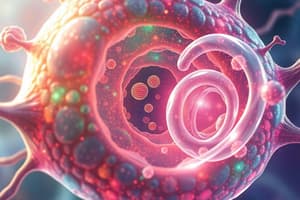Podcast
Questions and Answers
What did Robert Hooke observe when he looked at a thin slice of cork?
What did Robert Hooke observe when he looked at a thin slice of cork?
- Hollow room-like structures (correct)
- Animal cells only
- Microscopic fungi
- Living bacteria
Which scientist first observed living cells and referred to them as 'animalcules'?
Which scientist first observed living cells and referred to them as 'animalcules'?
- Anton van Leeuwenhoek (correct)
- Robert Hooke
- Matthias Schleiden
- Rudolph Virchow
What principle did Rudolph Virchow establish regarding living cells?
What principle did Rudolph Virchow establish regarding living cells?
- Only plant cells are made of cells
- All living cells come from other living cells (correct)
- Cells can spontaneously generate from non-living matter
- All cells are identical in structure and function
What incorrect theory was disproven by Lazzaro Spallanzani's experiments?
What incorrect theory was disproven by Lazzaro Spallanzani's experiments?
What did the early-nineteenth-century biological thought focus on regarding life's origin?
What did the early-nineteenth-century biological thought focus on regarding life's origin?
What significant advancement allowed for the definitive proof of the neuron theory?
What significant advancement allowed for the definitive proof of the neuron theory?
Which philosopher is known for his experimental approach and animal dissections?
Which philosopher is known for his experimental approach and animal dissections?
Who is credited with the invention of the microscope?
Who is credited with the invention of the microscope?
What was the influential concept proposed by Anaximander regarding evolution?
What was the influential concept proposed by Anaximander regarding evolution?
Which statement aligns with Aristotle's views on reproduction?
Which statement aligns with Aristotle's views on reproduction?
Which concept is attributed to Democritus, linking biology and atomic theory?
Which concept is attributed to Democritus, linking biology and atomic theory?
Which role did Plato play in the development of biological thinking?
Which role did Plato play in the development of biological thinking?
How do non-living things 'grow'?
How do non-living things 'grow'?
Which of the following is true about the movement of non-living things?
Which of the following is true about the movement of non-living things?
What is the significance of protoplasm in living things?
What is the significance of protoplasm in living things?
How do non-living things respond to changes in their environment?
How do non-living things respond to changes in their environment?
What defines the immortality of non-living things?
What defines the immortality of non-living things?
Which statement accurately reflects non-living things compared to living things?
Which statement accurately reflects non-living things compared to living things?
In terms of cell structure, how do non-living things differ from living things?
In terms of cell structure, how do non-living things differ from living things?
What characterizes the M Phase of the cell cycle?
What characterizes the M Phase of the cell cycle?
During which phase of mitosis does chromosomal material begin to condense?
During which phase of mitosis does chromosomal material begin to condense?
What happens to the nuclear envelope during prophase?
What happens to the nuclear envelope during prophase?
In which phase do chromosomes align at the metaphase plate?
In which phase do chromosomes align at the metaphase plate?
What structure helps spindle fibers attach to chromosomes during metaphase?
What structure helps spindle fibers attach to chromosomes during metaphase?
What happens to chromatids during anaphase?
What happens to chromatids during anaphase?
What occurs during telophase?
What occurs during telophase?
What is the main function of cytokinesis in the cell cycle?
What is the main function of cytokinesis in the cell cycle?
What characteristic is NOT true about anaphase?
What characteristic is NOT true about anaphase?
Flashcards
Robert Hooke
Robert Hooke
English scientist who observed tiny, hollow, room-like structures in cork under a microscope, calling them 'cells' due to their resemblance to monks' rooms.
Anton van Leeuwenhoek
Anton van Leeuwenhoek
Dutch scientist who used a simple microscope to observe living cells in blood, rainwater, and teeth scrapings, some of which were later called bacteria.
Matthias Schleiden
Matthias Schleiden
German botanist known for his discovery that plant parts are composed of cells.
Theodor Schwann
Theodor Schwann
Signup and view all the flashcards
Rudolph Virchow
Rudolph Virchow
Signup and view all the flashcards
Who was Anaximander and what was his contribution to biology?
Who was Anaximander and what was his contribution to biology?
Signup and view all the flashcards
How did Plato impact biological studies?
How did Plato impact biological studies?
Signup and view all the flashcards
Who was Democritus and what was his main contribution to biology?
Who was Democritus and what was his main contribution to biology?
Signup and view all the flashcards
Why is Aristotle considered important for biological studies?
Why is Aristotle considered important for biological studies?
Signup and view all the flashcards
What was the impact of the invention of the microscope on biology?
What was the impact of the invention of the microscope on biology?
Signup and view all the flashcards
Who is credited with inventing the microscope?
Who is credited with inventing the microscope?
Signup and view all the flashcards
What is the neuron theory and how was it proven?
What is the neuron theory and how was it proven?
Signup and view all the flashcards
M phase
M phase
Signup and view all the flashcards
Prophase
Prophase
Signup and view all the flashcards
Metaphase
Metaphase
Signup and view all the flashcards
Anaphase
Anaphase
Signup and view all the flashcards
Telophase
Telophase
Signup and view all the flashcards
Cytokinesis
Cytokinesis
Signup and view all the flashcards
Kinetochores
Kinetochores
Signup and view all the flashcards
Centromere
Centromere
Signup and view all the flashcards
Centrioles
Centrioles
Signup and view all the flashcards
Non-living things lack life.
Non-living things lack life.
Signup and view all the flashcards
Absence of cells in non-living things
Absence of cells in non-living things
Signup and view all the flashcards
No protoplasm in non-living things
No protoplasm in non-living things
Signup and view all the flashcards
Variable Shape in Non-living things
Variable Shape in Non-living things
Signup and view all the flashcards
External influence on non-living things
External influence on non-living things
Signup and view all the flashcards
Growth in non-living things
Growth in non-living things
Signup and view all the flashcards
Immortality of non-living things
Immortality of non-living things
Signup and view all the flashcards
Non-living things cannot reproduce.
Non-living things cannot reproduce.
Signup and view all the flashcards
Absence of life processes in non-living things
Absence of life processes in non-living things
Signup and view all the flashcards
Study Notes
History and Present Trends in Cell Biology
- Robert Hooke first discovered and named the cell in 1665, observing dead cell walls in cork.
- Hooke's observations were documented in Micrographia.
- Anton van Leeuwenhoek, in 1674, was the first to observe a live cell, the alga spirogyra, under a microscope.
- The invention of the telescope made the Cosmos accessible to observation.
- The invention of the microscope revealed the identities of microbes and allowed the observation of living forms.
Cell Theory
- In 1838, Theodor Schwann and Matthias Schleiden formulated early conclusions about cells.
- Cells are the fundamental units of structure, physiology, and organization in living organisms.
- Cells retain independence as distinct entities while contributing to the structure of organisms.
- Cells form through the division of pre-existing cells, according to Rudolf Virchow.
Modern Cell Theory
- All living organisms are composed of cells.
- Cells arise from pre-existing cells.
- Cells contain hereditary information passed during division.
- Cells exhibit a basic similarity in composition.
- Energy flow and biochemical processes in life occur within cells.
Timeline of Cell Research
- 1595 - Janssen credited with first compound microscope.
- 1655 - Hooke described "cells" in cork.
- 1674 - Leeuwenhoek discovered protozoa and bacteria.
- 1833 - Brown described cell nuclei.
- 1838 - Schleiden and Schwann proposed the cell theory.
- 1856 - Pringsheim observed sperm entering egg.
- 1858 - Virchow's famous conclusion: "Omnis cellula e cellula".
- 1951 - Gey and coworkers established the HeLa cell line.
- Various dates for subsequent scientific advancements in cell biology(including dates involving microscopy, gene expression, and manipulation tools for cells)
The Cell
- The cell is the basic structural and functional unit of all living organisms.
- Cells are comprised of both membrane bound and non membrane bound organelles.
- Cells have various organelles and structures performing designated functions to maintain homeostasis in the cell.
Cell Organelles
- Nucleus: The control center, containing DNA.
- Mitochondria: Powerhouses of the cell, responsible for energy production.
- Endoplasmic Reticulum (ER): Network of membranes involved in protein and lipid synthesis.
- Golgi apparatus: Modifies, sorts, and packages proteins and lipids.
- Ribosomes: Site of protein synthesis.
- Vacuoles: Storage sacs.
- Chloroplasts: Site of photosynthesis in plant cells.
- Cytoskeleton: Provides structure and support.
- Cell membrane: Selectively permeable barrier surrounding the cell.
- Centrosome and Centrioles: Involved in cell division.
Cell Cycle
- A cyclical series of events leading to cell growth and division.
- Includes Interphase (G1, S, G2) and Mphase (mitosis).
- Mitosis is further divided into Prophase, Metaphase, Anaphase, and Telophase and Cytokinesis
Evolution
- The theory of natural selection explains how species evolve over time.
- Species keep evolving or changing over time due to environmental changes.
- Adaptations are required by species due to environment pressure.
Heredity
- Genetics is the study of heredity and its related biological processes.
- Gregor Mendel established principles of inheritance.
- Mendel showed how characteristics are passed on in living organisms.
Studying That Suits You
Use AI to generate personalized quizzes and flashcards to suit your learning preferences.




